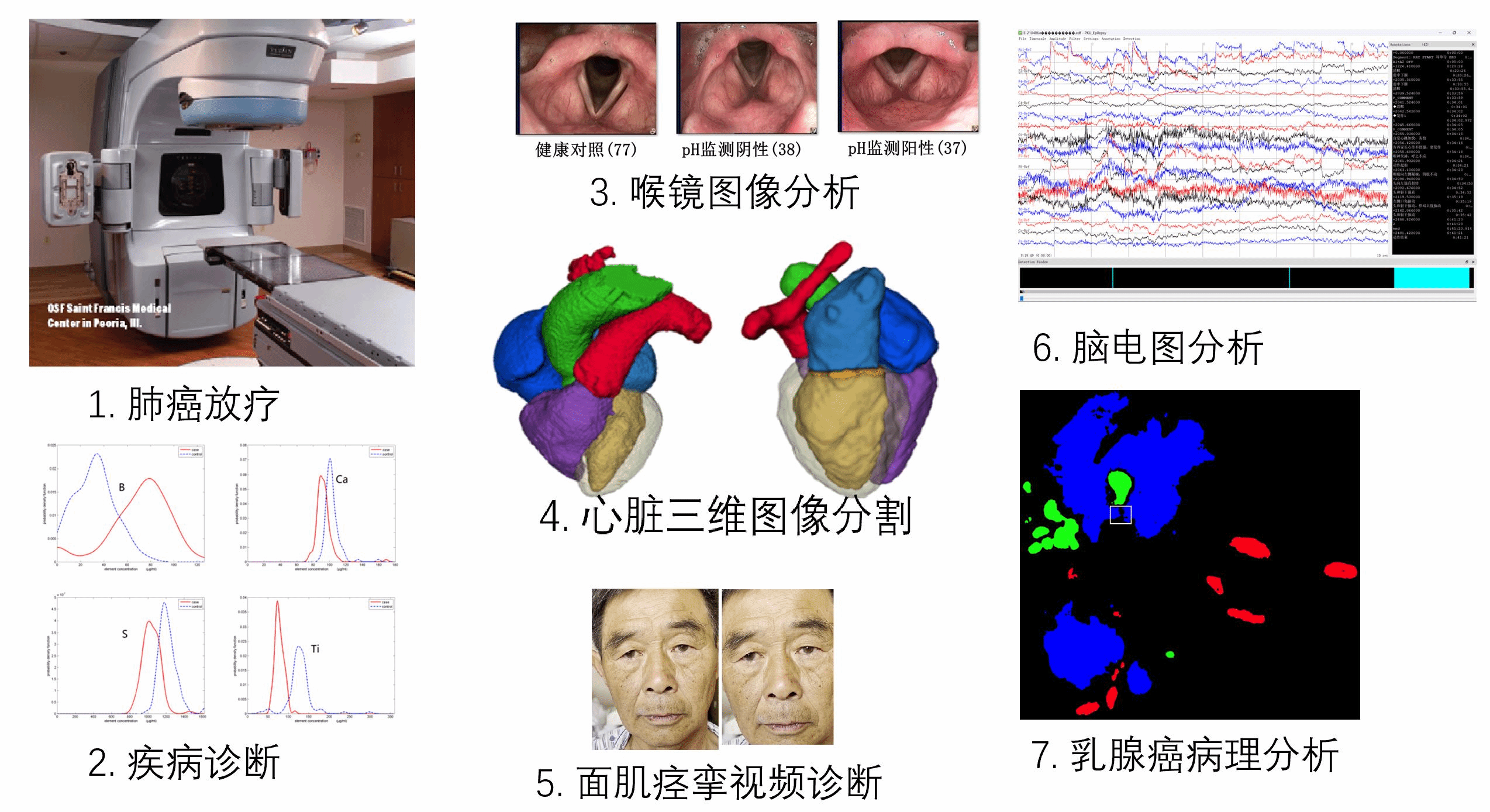
"The future of computing is the computer that talks, listens, sees and learns."
"Wake up everyday with a feeling of passion for the difference technology will make in people's lives."
"Publish, or perish."
"Few, but ripe."

Tong Lin, Ph.D.
Associate Professor
National Key Laboratory of General Artificial Intelligence,
School of Intelligence Science and Technology,
Peking University, Beijing 100871, China
Email: lintong [at] pku [dot] edu [dot] cn
ORCID: https://orcid.org/0000-0002-0000-834X
Biography:
Tong Lin received the PhD degree in Applied Mathematics from Peking University in 2001. In 1999 and 2000, he was a visiting student at the Media Computing Group, Microsoft Research Asia. In 2002, he joined the Key Laboratory of Machine Perception at Peking University, China, where he is currently an associate professor. From 2004 to 2005, he was an exchange scholar at Seoul National University, Korea. From 2007 to 2008, he was an exchange scholar at UCSD Moores Cancer Center, CA, USA. His recent research interests are machine learning algorithms, with applications in medical data analysis.
Teaching Courses:
[2] Tutorial Practice of Deep Learning Algorithms, for undergraduate students since 2021.
[1] Machine Learning, for graduate students since 2013.
Selected Publications:
[4] J. Dong, T. Lin*, “MarginGAN: Adversarial Training in Semi-Supervised Learning”, Proc. Neural Information Processing Systems (NeurIPS), Vancouver, Canada, Dec. 8-14, 2019. ![]() 2019-NeurIPS19-MarginGAN-Dong.pdf
2019-NeurIPS19-MarginGAN-Dong.pdf
[3] T. Lin*, H. Xue, L. Wang, B. Huang, H. Zha,“Supervised Learning via Euler's Elastica Models,” Journal of Machine Learning Research (JMLR), vol. 16 (Dec): 3637-3686, 2015. ![]() 2015-JMLR-lin-elastic.pdf
2015-JMLR-lin-elastic.pdf
[2] T. Lin*, H. Xue, L. Wang, and H. Zha, "Total Variation and Euler's Elastica for Supervised Learning," Int. Conf. Machine Learning (ICML), Edinburgh, Scotland, UK, June 26-July 1, 2012. ![]() 2012-ICML-Xue-Lin.pdf
2012-ICML-Xue-Lin.pdf
[1] T. Lin* and H. Zha, "Riemannian Manifold Learning," IEEE Trans. Pattern Analysis and Machine Intelligence (TPAMI), vol. 30, no. 5, pp. 796-809, May 2008. ![]() 2008-PAMI-lin.pdf
2008-PAMI-lin.pdf
To Prospective Students:
Students with good mathematics training (not limited in Mathematics majors) and strong programming skills are welcome.
Note: There is a summer camp in June (or early July) every year for finding candidates of the graduate students for the next year. So you should contact me by email in February or March for asking about the matters of the summer camp. 请每年2-3月联系我,询问夏令营和科研实习相关事宜。
Previous Projects in Medical Applications:
Welcome any student interested in this subfield.

Book Chapters:
[2] Tong Lin & Hongbin Zha, "Riemannian Manifold", book chapter in “Computer Vision: A Reference Guide”, Katsushi Ikeuchi (ed.), Springer, Jan. 2020. ![]() 2020-RiemannianManifold-Lin.pdf
2020-RiemannianManifold-Lin.pdf
[1] Tong Lin & Yucheng Lin, “Markerless Tumor Gating and Tracking for Lung Cancer Radiotherapy based on Machine Learning Techniques”, book chapter of “Artificial Intelligence in Decision Support Systems for Diagnosis in Medical Imaging”, edited by K. Suzuki and Y. Chen, Springer, pp. 337-359, 2018. ![]() 2018-BookChapterDraft-Lin.pdf
2018-BookChapterDraft-Lin.pdf
Papers:
[55] Shijie Fang, Qianhan Feng, Tong Lin*, "VCC-INFUSE: Towards Accurate and Efficient Selection of Unlabeled Examples in Semi-supervised Learning," the 33rd International Joint Conference on Artificial Intelligence (IJCAI2024), Jeju Island, South Korea, Aug. 3-9, 2024. ![]() 2024-IJCAI-Fang&Feng-arxiv.pdf
2024-IJCAI-Fang&Feng-arxiv.pdf
[54] Qianhan Feng, Lujing Xie, Shijie Fang, Tong Lin*, "BaCon: Boosting Imbalanced Semi-Supervised Learning via Balanced Feature-Level Contrastive Learning", 38th AAAI Conference on Artificial Intelligence (AAAI-24), Vancouver, Canada, February 20-27, 2024. ![]() 2024-AAAI-Feng-BaCon.pdf
2024-AAAI-Feng-BaCon.pdf
[53] Zongpeng Zhang, Mingqing Xiao, Taoyun Ji, Yuwu Jiang, Tong Lin, Xiaohua Zhou, Zhouchen Lin, "Efficient and Generalizable Cross-patient Epileptic Seizure Detection through Spiking Neural Network", Frontiers in Neuroscience, Jan. 10, 2024. ![]() 2024-Frontiers-ZPZhang-EEG.pdf
2024-Frontiers-ZPZhang-EEG.pdf
[52] Zongpeng Zhang, Taoyun Ji, Mingqing Xiao, Wen Wang, Guojing Yu, Tong Lin*, Yuwu Jiang*, Xiaohua Zhou, Zhouchen Lin, "Cross-Patient Automatic Epileptic Seizure Detection Using Patient-Adversarial Neural Networks with Spatio-Temporal EEG Augmentation", Biomedical Signal Processing and Control (BSPC), Volume 89, March 2024, 105664. ![]() 2024-BSPC-ZPZhang.pdf
2024-BSPC-ZPZhang.pdf
[51] Shijie Fang, Jia Fu, Chen Du, Tong Lin*, Yan Yan*, "Identifying Laryngeal Neoplasms in Laryngoscope Images via Deep Learning Based Object Detection: A Case Study on an Extremely Small Data Set", Innovation and Research in BioMedical engineering (IRBM), 44(6), Dec. 2023, 100799. ![]() 2023-IRBM-Fang.pdf
2023-IRBM-Fang.pdf
[50] Zongpeng Zhang, Zenan Ling, Tong Lin, Zhouchen Lin*. "Gradient Descent Optimizes Normalization-Free ResNets", International Joint Conference on Neural Networks (IJCNN), Queensland, Australia, 18-23 June 2023. ![]() 2023-IJCNN-zpzhang.pdf
2023-IJCNN-zpzhang.pdf
[49] Yucong Liu, Shixing Yu, Tong Lin*. "Hessian Regularization of Deep Neural Networks: A Novel Approach based on Stochastic Estimators of Hessian Trace." Neurocomputing 536 (2023) 13-20, March 2023. ![]() 2023-NeuCom-YucongLiu.pdf
2023-NeuCom-YucongLiu.pdf
[48] Nan Ke, Tong Lin*, Zhouchen Lin, Xiao-Hua Zhou and Taoyun Ji. "Convolutional Transformer Networks For Epileptic Seizure Detection," ACM Conference on Information and Knowledge Management (CIKM), in Atlanta, Georgia, USA, Oct 17-22, 2022. ![]() 2022-CIKM-Ke.pdf
2022-CIKM-Ke.pdf
[47] Xiaohan Zou, Tong Lin*. "Efficient Meta-Learning for Continual Learning with Taylor Expansion Approximation," International Joint Conference on Neural Networks (IJCNN oral presentation), part of IEEE World Congress on Computational Intelligence, Padova, Italy, July 18-23, 2022. ![]() 2022-IJCNN-Zou.pdf
2022-IJCNN-Zou.pdf
[46] Z. Shao, J. Liu, T. Lin*. "Stochastic Euler Heavy Ball Method", The 33rd IEEE International Conference on Tools with Artificial Intelligence (ICTAI2021), November 1-3, 2021. ![]() 2021-ICTAI-Shao.pdf
2021-ICTAI-Shao.pdf
[45] Nan Ke, Tong Lin*, Zhouchen Lin, "Channel-Weighted Squeeze-and-Excitation Networks For Epileptic Seizure Detection," The 33rd IEEE International Conference on Tools with Artificial Intelligence (ICTAI2021), November 1-3, 2021. ![]() 2021-ICTAI-Ke.pdf
2021-ICTAI-Ke.pdf
[44] S. Guo, T. Lin*. "An Efficient non-Backpropagation Method for Training Spiking Neural Networks", The 33rd IEEE International Conference on Tools with Artificial Intelligence (ICTAI2021), November 1-3, 2021. ![]() 2021-ICTAI-Guo.pdf
2021-ICTAI-Guo.pdf
[43] B. Li, Y. Wang, L. Bai, Z. Wu, T. Lin*. "A Supervisory Mask Attentional Network for Person Re-Identification in Uniform Dress Scenes", The 33rd IEEE International Conference on Tools with Artificial Intelligence (ICTAI2021), November 1-3, 2021. ![]() 2021-ICTAI-BoLi.pdf
2021-ICTAI-BoLi.pdf
[42] Zhiyi Chen, Tong Lin*, “Principal Gradient Direction and Confidence Reservoir Sampling for Continual Learning”, 30th International Conference on Artificial Neural Networks (ICANN), Sept. 14-17, 2021. ![]() 2021-ICANN-id501-chen.pdf
2021-ICANN-id501-chen.pdf
[41] Xuan Tang, Tong Lin*, “Adversarial Variational Knowledge Distillation”, 30th International Conference on Artificial Neural Networks (ICANN), Sept. 14-17, 2021. ![]() 2021-ICANN-id514-Tang.pdf
2021-ICANN-id514-Tang.pdf
[40] Gen Ye, Tong Lin*, “Channel Capacity of Neural Networks”, 30th International Conference on Artificial Neural Networks (ICANN), Sept. 14-17, 2021. ![]() 2021-ICANN2021_id379_Ye.pdf
2021-ICANN2021_id379_Ye.pdf
[39] Shijie Fang, Tong Lin*, “Intra-Model Collaborative Learning of Neural Networks”, International Joint Conference on Neural Network (IJCNN), July 18-21, 2021. ![]() 2021-IJCNN-Fang.pdf
2021-IJCNN-Fang.pdf
[38] Gen Ye, Chen Du, Tong Lin, Yan Yan*, Jack Jiang, “Deep Learning for Laryngopharyngeal Reflux Diagnosis”, Applied Sciences. 2021; 11(11):4753. ![]() 2021-Applied-Sciences-Ye.pdf
2021-Applied-Sciences-Ye.pdf
[37] Zhongyi Ji, Xiao Han, Tong Lin* and Wenmin Wang, "A Dense-Gated U-Net for Brain Lesion Segmentation", IEEE Int. Conf. Visual Communications and Image Processing (VCIP), Dec.1-4, 2020. ![]() 2020-VCIP-Ji.pdf
2020-VCIP-Ji.pdf
[36] Jinhao Dong, Tong Lin*, “MarginGAN: Adversarial Training in Semi-Supervised Learning”, Proc. NeurIPS, Vancouver, Canada, Dec. 8-14, 2019. ![]() 2019-NeurIPS19-MarginGAN-Dong.pdf
2019-NeurIPS19-MarginGAN-Dong.pdf
[35] Hua-Mao Gu, Tong Lin, Xun Wang*, Shichao Zhang, “A Preliminary Geometric Structure Simplification for Principal Component Analysis,” Neurocomputing, Volume 336, Pages 46-55, 7 April 2019. ![]() 2019-NeurComp-Gu.pdf
2019-NeurComp-Gu.pdf
[34] Zhongxue Chen*, Yan Lu, Tong Lin, Qingzhong Liu,and Kai Wang, “Gene-based genetic association test with adaptive optimal weights,” Genetic Epidemiology, Volume 42, Issue 1, pages 95-103, February 2018. ![]() 2018-GeneticEpidemiology-zxchen.pdf
2018-GeneticEpidemiology-zxchen.pdf
[33] Zhongxue Chen*, Tong Lin, and Kai Wang, “A powerful variant-set association test based on chi-square distribution,” Genetics, Nov. 1, 2017; 207(3):903-910 ![]() 2017-genetics-zxchen.pdf
2017-genetics-zxchen.pdf
[32] Tong Lin, Tiebing Liu, Yucheng Lin, Chaoting Zhang, Lailai Yan, Zhongxue Chen, Zhonghu He*, Jingyu Wang*, “Serum Levels of Chemical Elements in Esophageal Squamous Cell Carcinoma in Anyang, China — A Case-control Study Based on Machine Learning Methods,” BMJ Open 2017; 7: e015443. doi: 10.1136/bmjopen-2016-015443 ![]() 2017-bmjopen-esophageal-lin.pdf
2017-bmjopen-esophageal-lin.pdf
[31] Tong Lin, Tiebing Liu, Yucheng Lin, Lailai Yan, Zhongxue Chen, Jingyu Wang*, “Comparative Study on Serum Levels of Macro and Trace Elements in Schizophrenia based on Supervised Learning Methods,” Journal of Trace Elements in Medicine and Biology (JTEMB), 43:202-208, 2017. ![]() 2017-JTEMB-Schizophrenia-lin.pdf
2017-JTEMB-Schizophrenia-lin.pdf
[30] Y. Lin, L. Yang, Z Lin*, T. Lin, H. Zha, “Factorization for Projective and Metric Reconstruction via Truncated Nuclear Norm,” 2017 International Joint Conference on Neural Networks (IJCNN 2017), May 14-19, 2017, Anchorage, Alaska, USA. ![]() 2017-IJCNN-YangLin.pdf
2017-IJCNN-YangLin.pdf
[29] T. Lin, Y. Liu, B. Wang, L. Wang, H. Zha, “Nonlinear Dimensionality Reduction by Local Orthogonality Preserving Alignment,” Journal of Computer Science and Technology (JCST), 31(3): 512-524, 2016. ![]() 2016-JCST-lin.pdf
2016-JCST-lin.pdf
[28] T. Lin, Y. Liu, B. Wang, L. Wang, H. Zha, “Local Orthogonality Preserving Alignment for Nonlinear Dimensionality Reduction,” The Fourth International Conference on Computational Visual Media (CVM 2016), Cardiff, UK, April 6-8, 2016. ![]() 2016-CVM-Cardiff-Lin.pdf
2016-CVM-Cardiff-Lin.pdf
[27] T. Lin, H. Xue, L. Wang, B. Huang, H. Zha, “Supervised Learning via Euler's Elastica Models,” Journal of Machine Learning Research (JMLR), vol. 16 (Dec): 3637-3686, 2015. ![]() 2015-JMLR-lin-elastic.pdf
2015-JMLR-lin-elastic.pdf
[26] T. Lin, S. Liu, and H. Zha, "Incoherent Dictionary Learning for Sparse Representation," 21st Int. Conf. Pattern Recognition (ICPR), Tsukuba, Japan, Nov. 11-15, 2012. ![]() 2012-ICPR12-lin.pdf
2012-ICPR12-lin.pdf
[25] T. Lin, H. Xue, L. Wang, and H. Zha, "Total Variation and Euler's Elastica for Supervised Learning," 29th Int. Conf. Machine Learning (ICML), Edinburgh, Scotland, UK, June 26-July 1, 2012. ![]() 2012-ICML-Xue-Lin.pdf
2012-ICML-Xue-Lin.pdf
[24] Y. Ji, T. Lin*, and H. Zha, "CDP Mixture Models for Data Clustering," 20th Int. Conf. Pattern Recognition (ICPR), 23-26 August, 2010, Istanbul Turkey. ![]() 2010-ICPR-Ji.pdf
2010-ICPR-Ji.pdf
[23] X. Tang, T. Lin, and S.B. Jiang, "A Feasibility Study of Treatment Verification Using EPID Cine Images for Hypofractionated Lung Radiotherapy," Physics in Medicine and Biology (PMB), vol. 54, no. 18,pp. S1-S8, 2009. ![]() 2009-PMB-tang.pdf
2009-PMB-tang.pdf
[22] T. Lin, R. Li, X. Tang, J.G. Dy, and S.B. Jiang, "Markerless Gating for Lung Cancer Radiotherapy based on Machine Learning Techniques," Physics in Medicine and Biology (PMB), Institute of Physics (IOP), vol. 54, no. 6,pp. 1555-1563, 21 March 2009. ![]() 2009-PMB-lin-gating.pdf
2009-PMB-lin-gating.pdf
[21] T. Lin, L.I. Cervino, X. Tang, N. Vasconcelos, and S.B. Jiang, "Fluoroscopic Tumor Tracking for Image-Guided Lung Cancer Radiotherapy," Physics in Medicine and Biology (PMB), Institute of Physics (IOP), vol. 54, no. 4, pp. 981-992, 21 Feb. 2009. ![]() 2009-PMB-lin-tracking.pdf
2009-PMB-lin-tracking.pdf
[20] Y. Ji, T. Lin*, and H. Zha, "Mahalanobis Distance Based Non-negative Sparse Representation for Face Recognition," The Eighth International Conference on Machine Learning and Applications (ICMLA), Oral Presentation, Miami, Florida, USA, Dec. 13-15, 2009. ![]() 2009-ICMLA-Ji.pdf
2009-ICMLA-Ji.pdf
[19] Y. Geng, T. Lin, Z. Lin, and P. Hao, "Refined Exponential Filter with Applications to Image Restoration and Interpolation," The Ninth Asian Conference on Computer Vision (ACCV), Xi'an, China, Sept. 23-27, 2009. ![]() 2009-ACCV-geng.pdf
2009-ACCV-geng.pdf
[18] T. Lin and H. Zha, "Riemannian Manifold Learning," IEEE Trans. Pattern Analysis and Machine Intelligence (TPAMI), vol. 30, no. 5, pp.796-809, May 2008. ![]() 2008-PAMI-lin.pdf
2008-PAMI-lin.pdf
[17] T. Lin, L. Cervino, X. Tang, N. Vasconcelos, and S.B. Jiang, "Tumor Targeting for Lung Cancer Radiotherapy Using Machine Learning Techniques," Seventh International Conference on Machine Learning and Applications (ICMLA), pp. 533 - 538, San Diego, USA, 11-13 Dec. 2008. ![]() 2008-ICMLA-lin.pdf
2008-ICMLA-lin.pdf
[16] X. Tang, T. Lin, and S.B. Jiang, "Towards On-line Treatment Verification Using cine EPID for Hypofractionated Lung Radiotherapy," Seventh International Conference on Machine Learning and Applications (ICMLA), pp.551 - 555, San Diego, USA, 11-13 Dec. 2008. ![]() 2008-ICMLA-tang.pdf
2008-ICMLA-tang.pdf
[15] T. Lin, P. Hao, and S. Xu, "Matrix Factorizations for Reversible Integer Implementation of Orthonormal M-Band Wavelet Transforms," Signal Processing (SP), Elsevier, vol. 86, no. 8, pp. 2085-2093, Aug. 2006. ![]() 2006-SP-lin.pdf
2006-SP-lin.pdf
[14] T. Lin, S. Xu, Q. Shi, and P. Hao, "An Algebraic Construction of Orthonormal M-Band Wavelets with Perfect Reconstruction", Applied Mathematics and Computation (AMC), Elsevier, vol. 172, no. 2, pp. 717-730, Jan. 2006. ![]() 2006-AMC-lin.pdf
2006-AMC-lin.pdf
[13] T. Lin, H. Zha, and S. Lee, “Riemannian Manifold Learning for Nonlinear Dimensionality Reduction,” 9th European Conference on Computer Vision (ECCV), Oral Presentation, LNCS 3951, vol 1, pp. 44-55, Graz, Austria, May 7-13, 2006. ![]() 2006-ECCV-lin.pdf
2006-ECCV-lin.pdf
[12] T. Lin and P. Hao, “Compound Image Compression for Real-Time Computer Screen Image Transmission”, IEEE Trans. Image Processing (TIP), vol. 14, no. 8, pp.993-1005, 13 pages, Aug. 2005. ![]() 2005-TIP-lin.pdf
2005-TIP-lin.pdf
[11] T. Lin, P. Hao, and S. Lee, “Efficient Coding of Computer Generated Compound Images,” IEEE Int. Conf. Image Processing (ICIP), vol 1, pp. 561-564, Genoa, Italy, Sept. 11-14, 2005. ![]() 2005-ICIP-tlin.pdf
2005-ICIP-tlin.pdf
[10] T. Lin, P. Hao, and S. Xu, "Factoring M-Band Wavelet Transforms into Integer Mapping Steps and Lifting Steps," IEEE Int. Conf. Acoustics, Speech, and Signal Processing (ICASSP), Philadelphia, USA, March 19-23,2005. ![]() 2005-ICASSP-tlin.pdf
2005-ICASSP-tlin.pdf
[9] T. Lin, P. Hao, C. Xu, and J. Feng, “Hybrid Image Coding for Real-TimeComputer Screen Video Transmission”, Visual Communications and ImageProcessing (VCIP), part of the IS&T/SPIE Symposium on Electronic Imaging, San Jose, CA, USA, Jan. 18-22, 2004. ![]() 2004-VCIP-lin.pdf
2004-VCIP-lin.pdf
[8] T. Lin, Q. Shi, and P. Hao, "An Algebraic Approach to M-Band WaveletsConstruction," IASTED Int. Conf. Signal and Image Processing (SIP), Hawaii, USA, Aug. 13-15, 2003. ![]() 2003-ICSIP-lin.pdf
2003-ICSIP-lin.pdf
[7] T. Lin, H. Zhang, J. Feng, and Q. Shi, "Shot Content Analysis for VideoRetrieval Applications," Journal of Software (in Chinese), vol. 13, no.8, pp. 1577-1585, Aug. 2002. ![]() 2002-JOS-lin.pdf
2002-JOS-lin.pdf
[6] T. Lin, H. Zhang, and Q. Shi, “Video Content Representation for ShotRetrieval and Scene Extraction,” Int. Journal of Image and Graphics (IJIG), vol. 1, no. 3, pp. 507-526, Aug. 2001. ![]() 2001-IJIG-lin.pdf
2001-IJIG-lin.pdf
[5] T. Lin, C. Ngo, H. Zhang, and Q. Shi, “Integrating Color and Spatial Featuresfor Content-Based Video Retrieval,” IEEE Int. Conf. Image Processing (ICIP), Invited paper, Thessaloniki, Greece, Oct. 7-10, 2001. ![]() 2001-ICIP-lin.pdf
2001-ICIP-lin.pdf
[4] T. Lin, H. Zhang, and Q. Shi, “Video Scene Extraction by Force Competition”, IEEE Int. Conf. Multimedia and Expo (ICME), Tokyo, Japan, Aug. 22-25, 2001. ![]() 2001-ICME-lin.pdf
2001-ICME-lin.pdf
[3] T. Lin, and Q. Shi, "Image Segmentation by an Edge Growing Method,"Journal of Image and Graphics (in Chinese), no. 11, pp. 911-915, Nov. 2000. ![]() 2000-JIG-lin.pdf
2000-JIG-lin.pdf
[2] T. Lin and H. Zhang, “Automatic Video Scene Extraction by Shot Grouping”, Int. Conf. Pattern Recognition (ICPR), Oral presentation, Barcelona, Spain,Sept. 3-8, 2000. ![]() 2000-ICPR-tlin.pdf
2000-ICPR-tlin.pdf
[1] H. Jiang, T. Lin and H. Zhang, “Video Segmentation with the Support of AudioSegmentation and Classification”, IEEE Int. Conf. Multimedia and Expo (ICME), Oral presentation, New York, USA, July 31-Aug. 2, 2000. ![]() 2000-ICME-jiang.pdf
2000-ICME-jiang.pdf

地址:北京市海淀区颐和园路5号(62755617) 反馈意见:its@pku.edu.cn
Copyright 版权所有©js333金沙(中国)官方网站 -官网线路检测登录入口 -Apple App store All Rrights Reserved.
